In this article, we will discover how to grow ivy in containers and how to get the best from them. Ivy is such a delightful plant growing against walls or fences, where a green mural is generated.
They are ideal if you have a large vertical surface area to cover, where boring walls and fences can be lifted without the need to ever paint them again.
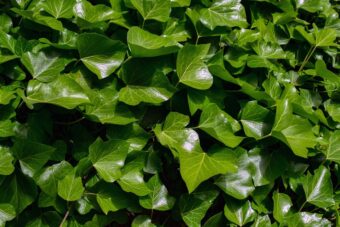
Ivy is a self-clinging climber that spreads rapidly via the aerial roots that it produces. These roots will readily cling to brick walls and will not require any support structure to be used, once the plant has established. A plant that clings by itself.
The roots also make it an ideal ground cover, where new plants are generated when the roots touch the ground and its roots. It can, therefore, grow very vigorously and to great lengths, unless you are prepared to curtail them. One way to do this is to grow them in containers, as the plant does tend to take over gardens.
THE LEAVES MAKE THE PLANT
As said previously the plant is prized for its handsome, evergreen leaves that can be dark green or variegated, and its ability to cover large surface areas.
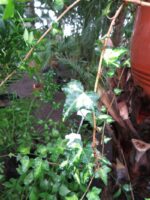
If you have a wire metal fence to cover then Ivy makes an ideal screen, allowing light in, but also increasing your privacy. It is a dual-purpose plant, where it can cover a large wall very quickly to give a warm, homely feel or it can look great cascading over the side of hanging baskets, where the greenery will contrast with beautiful bedding plants.
In effect, it can be allowed to grow to large proportions or it can be used annually in a scheme to give added, beauty to hanging baskets. It can be allowed to grow up or it can be allowed to trail downwards.
WHY IVY IS LIKED AND DISLIKED BY GARDENERS?
The main reason why it is liked is that it is an unfussy plant that can be grown in full sun to full shade. Ivy can even withstand a lack of rainfall and that pests and diseases do not trouble this climber.
It is fully hardy but in containers, they do not always survive especially of the winter is harsh and prolonged. It is therefore recommended that you do not plant it in a frost pocket, but in a container where the plant within it is sheltered a little bit from the harsh, winter weather.
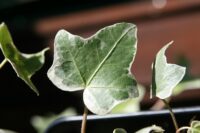
Why gardeners hate ivy is because it can become invasive and will swamp any plants around it, suffocating them.
They will literally take over your garden, although in containers the rampant growth will be controlled. Any gardener will testify that once you have ivy on the garden, it can be difficult to kill as the roots are nearly indestructible. You have to use strong weed and stump killers and then it may still come back.
If ivy grows over any other plant near it, it will kill it. It is advised not to grow any other plants near ivies if you want them to live and flourish.
In this article, we will concentrate on English ivy, as Boston ivies will be discussed in a separate article. The beauty of growing English ivy is that you have many varieties to choose from that will survive a typical English winter.
THE BEST GROWING CONDITIONS
It is best to grow ivy in the shade or partial shade. This is because, in very cold winters, the winter sun can burn the leaves, giving an unattractive look. Although, as said previously, it can tolerate droughts, it does not like very dry climates, where the climber will suffer and start shedding leaves.
GROWING IVY IN CONTAINERS
First, chose a pot that has a diameter that is 10cm bigger than the container the plant came in. Make sure there are drainage holes at the bottom of the pot, which is an absolute must. A large pot will take some time to fill as the roots will grow first before new shoots are generated and observed at the top.
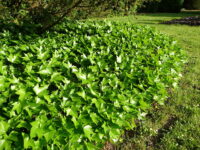
Fill the pot with a third of the way with a good multipurpose compost that is well-drained but moisture retentive.
Remove the ivy from its pot, loosen the root ball by gently teasing the roots from the bottom. Insert the root ball at the centre of the pot and on top of the compost. Fill the rest with more compost and fill any gaps that remain, whilst firming the plant in.
Ensure there is a 12cm gap left between the top of the container and the top of the compost level. Make sure that the plant is not protruding (planted higher than it was in the original container) or the plant is planted deeper than it was in the original container.
You will then need to water thoroughly and continue to water frequently until the plant establishes.
WILTING IS NOT A PROBLEM AT THE BEGINNING
Do not worry if your plants start to wilt after repotting, as this is transplant shock. You plant will soon recover, once the roots get used to the new surroundings.
If your plant is unstable the root ball may have been planted too shallow, you will need to repot the plant to ensure the plant is properly firmed in.
You may need to feed once during the growing season. With a granular fertiliser, but do not overfeed as this can lead to rampant growth. Over-fertilizing can lead also to root rot, so please be careful when you feed this plant and how much you give to the plant.

To control the vine and keep it more manageable, you will need to prune in spring. This will keep it in shape and will also promote bushier growth.
Once the plant has become root bound, you will need to pot on to help the plant to grow on. I would keep moving up to the next available pot size until the container reaches a diameter of half a barrel and no more.
You need to keep the plant growth in check and restrict it slightly by keeping the plant slightly pot bound. You will need to repot on when the plant is showing signs of struggling because it is potbound (The plant is wilting and taking much more water than necessary).
VARIETIES TO GROW
Hedera helix (English Ivy) ‘Glacier’. This is a variegated form of English Ivy that has green, silver-cream, variegated leaves. A mature plant can produce flowers in autumn that are yellow-green and are followed by black fruits.
Hedera helix (English Ivy) ‘Goldheart’. This is another English ivy that has dark, glossy green leaves with golden yellow centres and tapered edges. In autumn, yellow-green flower clusters are produced that are followed by attractive, spherical, black fruits.
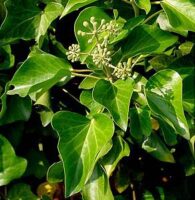
Hedera helix (English Ivy) ‘Green Ripple’ is a beautiful evergreen ivy that has vivid, green leaves with pale green veining. A wonderful ivy for cascading over the container or growing over low walls. A more manageable ivy.
Hedera canariensis ‘Gloire de Marengo’ is a vigorous ivy that has bright, glossy, variegated, large green leaves and bright red leaf stalks. It needs to be grown in dappled shade, where the variegation will be highlighted. Grow it in ericaceous compost in a sheltered spot, away from cold winds.
Hedera hibernica has dark, glossy leaves and great for covering a large area of walls and fences. Not a fussy plant and can be pruned back at any time. When you prune be careful as any sap produced can be irritating to the skin.
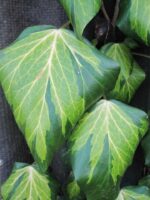
Hedera colchica ‘Dentata Variegata’ is an evergreen ivy with large, mottled, green leaves with cream edges. Grow it in partial shade, where glimpses of light can bring out its variegation.
Hedera colchica ‘Sulphur Heart’ is a similar plant to ‘Dentata Variegata’ but instead has dark and light green variegation that entices the dark, shady areas. The variegation gets more noticeable as the plant grows older, where it can contest well with Jasmimium nudiflorum.
CONCLUSIONS
In this article, we have discussed on how to grow ivy in containers to give dark areas with wall and fences in your garden extra beauty, as you can see it is not difficult to grow ivy in a container as long as you water sufficiently, do not overfeed and prune to keep the plant in check.
You have a choice of many varieties to grow, some more vigorous and some tamer. If you have a large surface area to cover you cannot beat an ivy, as long as you control its vigour.
If you have any questions or comments that you wish to make, please do so in the comment box below.
Happy ivy growing.

Fascinating post! I have never tried to grow Ivy in containers. It is actually very convenient, so it will not outgrow the garden. I have several Ivies. They are already more than 10 years old and flower always in October and November. I love them, even they grow everywhere, and I need to cut them to keep them in form. Bees and butterflies love them too. I think it is a great idea to plant them in containers. Then I don’t need to worry about my other plants. Do they grow big in the container? Or do they stay small?
Hi Silvia
Ivy does indeed bring much welcome greenery to blank surfaces and they can be problematic if you do not keep the rampant growth in check. In containers, the growth will not be as vigorous but they still do grow. The good thing is that in containers this will stop the plant from spreading and rooting everywhere.
Thanks
Antonio
There’s certainly more ivy varieties than I thought. I’m from Asia so Devil’s Ivy (Pothos) is pretty common here. They are a blend of yellow and green so it creates a lovely texture if you put the plant indoors. I used to grow them in small pots and they are really easy to care for – a little bit of sun, some clean water – and that’s it.
Until one day, all the leaves started turning yellow and brown. It spread over a few months and looked like they were having some diseases. Before I knew it, all of them were lifeless and I couldn’t get the new buds to grow anymore. Till this day, I couldn’t figure out the root of the problem. Was it the quality of the water? Was it too much sun? Was it overcrowding in the container? I don’t know.
Hi Cathy
I am sorry about your devil’s Ivy. It is more likely to be Root rot caused by overwatering the plant. They are very sensitive that way. It is important to make sure the plant receives the right amount of water, I hope that you will try again or you can try Hedera helix as they make wonderful houseplants as well.
Kind regards
Antonio